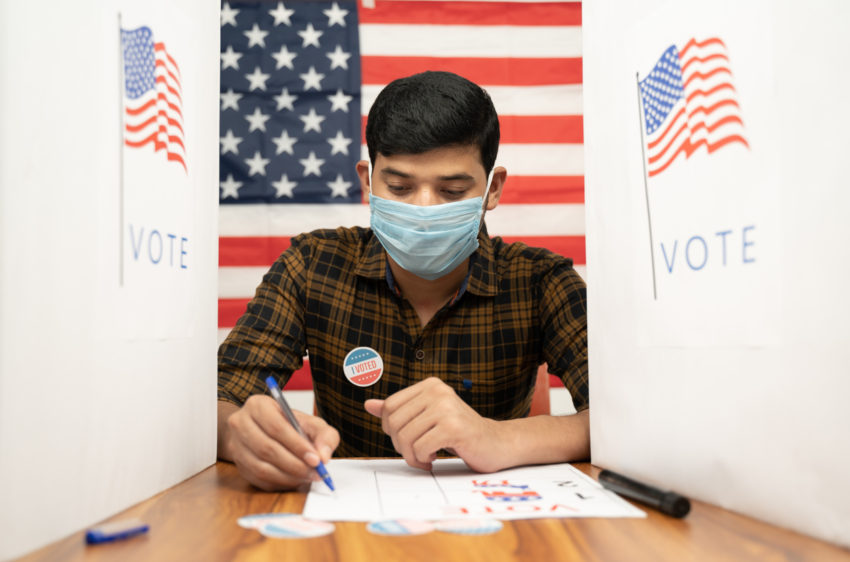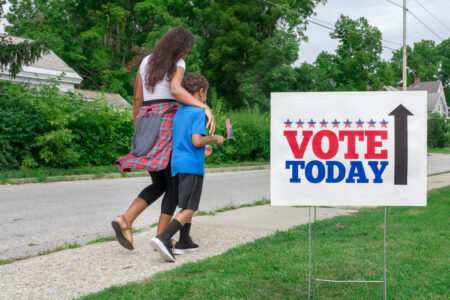
Share On Social!
As Latinos became the largest racial/ethnic minority in the U.S., researchers expected them to have a larger turnout in the 2020 Election compared to previous years.
They were right — 20.6 million Latinos voted this year, a 63% increase from the last presidential election.
While Latino voter turnout usually ends up being less than half of eligible voters, 64% of eligible Latinos turned out to vote.
The majority of Latinos voted for Joe Biden, but a growing number of Latinos voted for Donald Trump, surprising many Democrats and media outlets.
As we reflect on the 2020 Election, we find several takeaways about the Latino voting bloc: Latino voters vary in gender and age, the number of Latino voters increases each election, and the diversity within the Latino community contributes to differing political identities.
1. How did Latinos Vote?
To break down the Latino vote, we can look at how Latino men voted compared to Latina women, and how the overall Latino vote varied in different age groups:
- 70% of Latinos voted for Biden and 27% for Trump
- More Latinas voted for Biden (73%) than Latinos (67%)
- Middle-aged Latinos were slightly more likely to vote for Trump (29%) than young Latinos (27%)
- Elderly Latinos were more likely to support Biden than other age groups (75%)
Latinos had a decisive vote in several key states:
- In Arizona, 71% of Latino youth voted for Biden compared to 54% of young white voters
- In Texas, Latinos aged 18-29 were more likely to support Biden (73%) than young white voters (45%)
- In Nevada, Biden won 70% of Latino voters compared to Trump (25%)
It’s clear that Latino voters were a powerful force in the 2020 Election.
So why are politicians and media outlets still referring to Latinos as the “sleeping giant?”
2. Latino Voters and the ‘Sleeping Giant’ Myth
Latinos have long been referred to as a “sleeping giant” when it comes to their political power — a group that is powerful but remains dormant.
This metaphor has persisted in American politics for over three decades.
It speaks to how politicians often overlook Latino voters.
“It’s kind of amazing to me that every four years, there’s this idea that Latinos are about to break out of their shell and really determine elections; it’s like pundits and politicians rediscover them every four years,” said Geraldo Cadava, author of The Hispanic Republican: The Shaping of an American Political Identity, From Nixon to Trump, according to NPR.
The term plays into harmful stereotypes of Latinos.
“There are all of these caricatures of Mexicans dating back to the early to mid-20th century, of us wearing serapes and sombreros, leaning against a wall with a bottle of tequila. We’re always asleep and lazy, and it plays into this idea that we’re apathetic. So I think the whole image is not great,” Cadava said.
Politicians and media outlets continue to underestimate Latinos and call them a “sleeping giant.” But in reality, Latinos make up a significant portion of the voter base.

If you look at Latino voter turnout in past election, the number of voters consistently goes up:
- 2000 – 5.9 million
- 2004 – 7.6 million
- 2008 – 9.7 million
- 2012 – 11.2 million
- 2016 – 12.6 million
While it’s true that Latino voter turnout lies far below the number of eligible Latino voters, this shouldn’t be traced to Latinos “sleeping,” but rather to voter suppression tactics and to politicians who only superficially connect to Latino voters.
Another reason for that? The diversity within the Latino community.
3. Latino Voters: ‘We Are Not a Monolith’
How Latinos voted varied on the different identities and nationalities within the Latino community.
“We are not a monolith,” said Denise Hernández, a Chicana activist. “We all come from different cultural, sociopolitical identities. Cubans have a completely different political identity in a large part than Mexican Americans do in Texas. I can only speak to being a Mexican American in Texas. But I know our politics are going to be way different than a Puerto Rican in New York.”
The different groups among Latinos may prioritize different political issues.
While the pro-life movement and religious freedom may resonate with some voters, others might be more concerned about immigration.
While the majority of Latinos voted for Biden, some Latinos connected to Trump’s message on the economy and religion.
“Trump understood what motivated his Latino supporters—economic individualism, religious liberty, and law and order—and he made sure they knew he did,” said Cadava, according to The Atlantic.
The varying politics of different Latino groups can help people understand why Latinos don’t vote as uniformly as Black voters.
“Mexican Americans, the largest Hispanic group in the Southwest and across the nation, strongly supported Biden (74%) over Trump (23%), Cuban-Americans in Florida and beyond showed a preference for Trump (52%) over Biden (45%),” said Celeste Montoya, according to Fortune. “Other Hispanic groups, such as Puerto Ricans, Central Americans, and South Americans, all tended to support Biden, but to varying degrees.”
One thing is for certain: Latinos are becoming a more powerful force in politics. That means politicians will have to work harder to appeal to different groups among Latinos.
4. Don’t Take Latino Voters for Granted
While analysts may debate back and forth the reasons why the Latino vote is so different from other groups, the real focus should be on the strength of Latinos.
“The main story is that in an election which saw historic turnout, people of color — and especially Latinos — had an unprecedented increase in voting,” said Juan González, co-host of Democracy Now!
Latino voters have shown up and are continuing to come out to vote in bigger numbers each year.
But because of the diversity among Latinos, neither party should take these voters for granted.
“One thing is sure: Neither the Democratic nor Republican parties will underestimate or ignore Latino voters from now on,” González said.
5. Engage Latino Voters in More than Voting
We know Latinos wield quite a bit of power at the polls.
They also have power to accomplish healthy system and policy changes in their communities. Just take a look at some of these Salud America! Salud Heroes.
Still, you can’t take action to address health equity if you don’t know where the gaps are.
That’s why you should download a Health Equity Report Card from Salud America! at UT Health San Antonio. With the report card, you can see how many of your neighbors face inequities in food access, education, income, health care, and much more.
Then you can email your Health Equity Report Card to community leaders, share on social, and build the case to address health equity issues in at-risk areas!
GET YOUR HEALTH EQUITY REPORT CARD!
Explore More:
Increasing Civic EngagementBy The Numbers
50
percent
of big U.S cities have a local board of health




